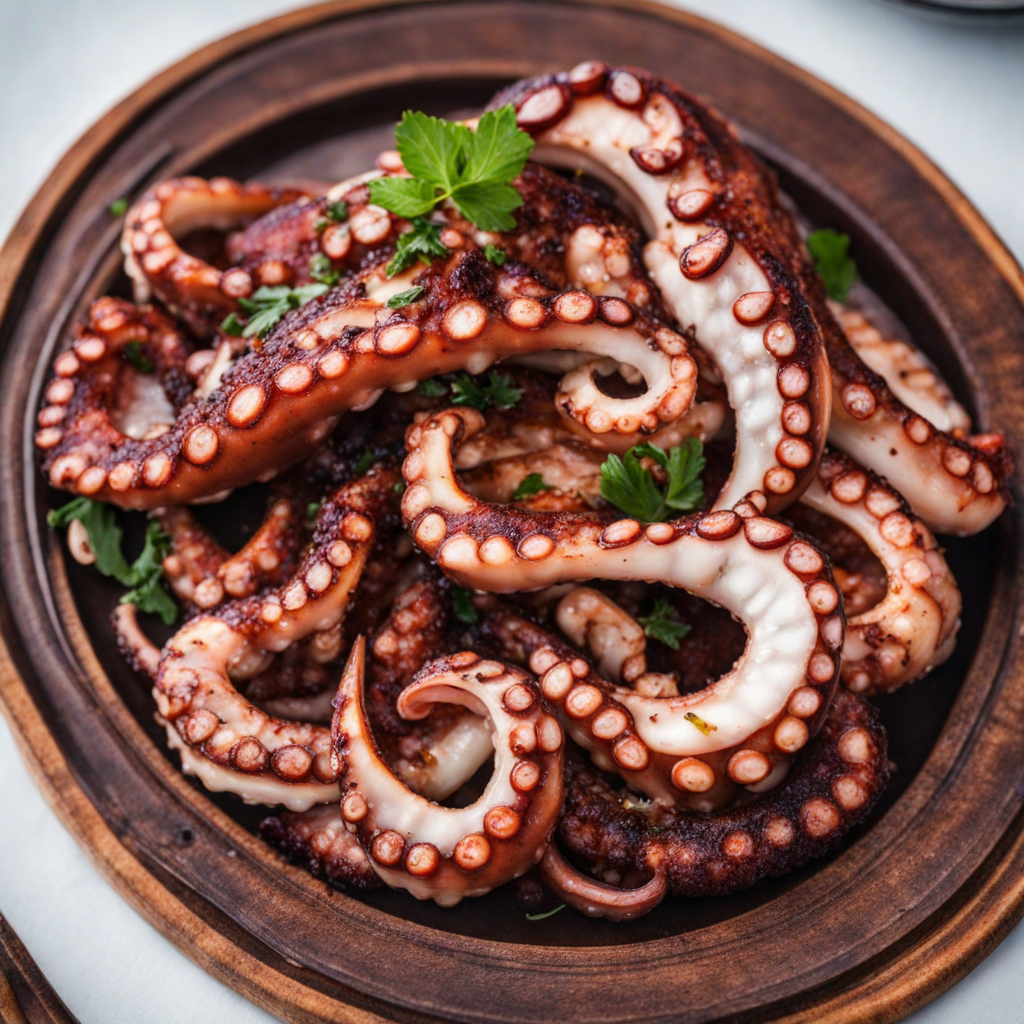Galaktoboureko
Galaktoboureko is a delightful Greek dessert that beautifully combines the rich flavors of custard and flaky pastry. At its core, this sweet treat features a luscious filling made from semolina, milk, sugar, and eggs, which is delicately flavored with hints of vanilla or lemon zest. The custard is creamy and smooth, providing a satisfying contrast to the crispy exterior. The layers of phyllo dough are brushed with melted butter before being baked to a golden perfection, resulting in a texture that is both crunchy and tender. Once baked, Galaktoboureko is generously soaked in a sweet syrup made from sugar, water, and a touch of lemon juice or orange blossom water. This syrup seeps into the pastry, adding sweetness and moisture, while the citrus notes elevate the overall flavor profile, creating a delightful balance. The syrup not only enhances the taste but also gives the dessert a beautiful glossy finish that is visually appealing. This traditional Greek delicacy is often served in square or rectangular pieces, making it easy to share and enjoy. Each bite offers a perfect harmony of textures and flavors – the crispness of the phyllo contrasts with the creamy custard, all enveloped in the sweet, fragrant syrup. Whether enjoyed at a festive gathering or as a comforting treat after dinner, Galaktoboureko is sure to transport your taste buds to the sunny shores of Greece.
How It Became This Dish
The History of Γαλακτομπούρεκο: A Sweet Journey Through Time #### Origins Γαλακτομπούρεκο, a beloved Greek dessert, is a delightful confection made of thin layers of phyllo pastry filled with a rich custard, typically flavored with vanilla or lemon, and topped with a sweet syrup. The name itself is derived from the Greek words "γάλα" (gala) meaning "milk," and "μπούρεκο" (boureko), which refers to a type of pastry. This sweet treat has deep roots in the culinary traditions of the Eastern Mediterranean, with its origins often traced back to the Byzantine Empire, where similar custard-filled pastries were enjoyed. The historical journey of Γαλακτομπούρεκο is entwined with the broader narrative of phyllo pastry, which has its own rich history. Phyllo, a word that means "leaf" in Greek, is a paper-thin dough that has been used in various forms across the Mediterranean and Middle Eastern regions for centuries. It is believed that the Ottomans were instrumental in perfecting the art of making phyllo, which spread throughout the territories they ruled, including Greece, where it became a staple in many traditional dishes. #### Cultural Significance In Greek culture, food is not merely sustenance; it is a vessel for tradition, community, and celebration. Γαλακτομπούρεκο, like many traditional Greek desserts, is often served during significant life events such as weddings, christenings, and religious holidays. Its creamy filling and flaky exterior make it a symbol of comfort and hospitality, embodying the warmth of Greek culture. The dessert also holds a place of pride in regional cuisines. While it is widely enjoyed throughout Greece, different regions have their own variations. For example, in the northern regions, particularly in Macedonia, Γαλακτομπούρεκο is often made with a thicker custard and may include the addition of local ingredients like semolina. In contrast, in the Cycladic islands, it might be prepared with a lighter syrup and a more delicate filling. The preparation and sharing of Γαλακτομπούρεκο can also be seen as a form of social bonding. Families often gather to make it together, passing down recipes through generations. This practice signifies not only the continuation of culinary traditions but also the importance of family ties and community in Greek society. #### Development Over Time As the centuries unfolded, the recipe for Γαλακτομπούρεκο evolved, reflecting the changing tastes and influences of the Greek people. During the Ottoman period, the blending of culinary traditions led to the incorporation of various spices and flavors. While the basic components of the dessert have remained consistent, variations began to emerge as regional ingredients and methods influenced the way it was prepared. In the 19th century, as Greece gained independence and began to define its national identity, traditional foods like Γαλακτομπούρεκο became a point of pride. The revival of interest in folk traditions during this time saw the dessert being celebrated not just as a delicious treat, but as a symbol of Greek heritage. Cookbooks began to emerge, documenting traditional recipes and helping to standardize methods of preparation, solidifying Γαλακτομπούρεκο’s place in the national culinary canon. The 20th century brought about further change, particularly in the post-war era. With urbanization and the migration of people from rural areas to cities, traditional foods began to adapt to modern lifestyles. As a result, variations of Γαλακτομπούρεκο began to appear in cafes and bakeries, often made with shortcuts that appealed to a fast-paced urban life. While some purists lamented these changes, many embraced the convenience of pre-made phyllo dough and the ability to enjoy this classic dessert in a more accessible form. #### Contemporary Popularity Today, Γαλακτομπούρεκο enjoys a resurgence in popularity, both in Greece and among Greek communities worldwide. It is celebrated not only for its delicious taste but also for its cultural significance. In Greek festivals and restaurants around the globe, you can find this dessert proudly featured on menus, showcasing its ability to bring people together. With the rise of social media and cooking shows, there has been a renewed interest in traditional Greek recipes. Home cooks and professional chefs alike have taken to experimenting with Γαλακτομπούρεκο, incorporating modern twists while respecting the essence of the traditional dish. Some versions now include creative fillings such as chocolate or fruit, while others play with the texture of the syrup or the addition of spices like cinnamon or cardamom. Moreover, the global trend towards artisanal and homemade foods has led to a greater appreciation for the craft of making Γαλακτομπούρεκο from scratch. Cooking classes and workshops focusing on traditional Greek desserts have become popular, allowing enthusiasts to learn the intricacies of working with phyllo and mastering the custard filling. #### Conclusion Γαλακτομπούρεκο is more than just a dessert; it is a reflection of Greek history, culture, and community. From its Byzantine origins to its contemporary adaptations, this beloved pastry has traversed time and geography, embodying the spirit of hospitality and tradition that characterizes Greek cuisine. As it continues to evolve, Γαλακτομπούρεκο remains a sweet reminder of the past, a connection to family and heritage, and a delicious treat that brings joy to many. Whether enjoyed at a festive gathering or as a simple indulgence at home, it is undoubtedly a cherished part of Greece's culinary landscape.
You may like
Discover local flavors from Greece







